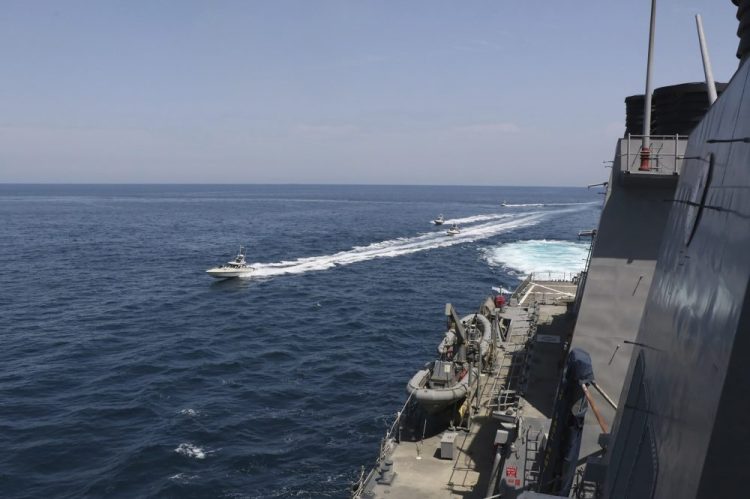WASHINGTON — Even before President Trump’s vow to “shoot down” Iranian speedboats if they harass American ships in international waters, the U.S. Navy was bolstering its ability to call in AC-130 gunships and Apache attack helicopters to defend its presence in the Persian Gulf.
A practice run for the new tactics on April 15 drew 11 gunboats from Iran’s Islamic Revolutionary Guard Corps that crossed the bows and sterns of American vessels at close range. And that prompted Trump’s tweet on April 22 saying he’d “instructed the United States Navy to shoot down and destroy any and all Iranian gunboats if they harass our ships at sea.”
Going back to the Obama administration, Revolutionary Guard members in small but agile speedboats have harassed U.S. ships, but the encounters usually have ended with warnings from the Americans to back off. As far back as 2007, the Office of Naval Intelligence estimated Iran had a fleet of 1,000 small boats that was growing. In early January 2017 a U.S. Navy guided-missile naval destroyer fired warning shots at four Iranian rapid-attack craft in the Strait of Hormuz.
While attention has turned on the latest confrontation at sea between Iran and the U.S. – and on Trump’s vow to stop such close encounters – there’s been little focus on the recent moves by the U.S. Central Command to come better-armed with joint Navy, Air Force and Army systems for spotting targets and transferring data.
The live-fire gunship exercises began in March as a first-time effort at coordination between Navy patrol coastal ships, the service’s P-8A Poseidon reconnaissance aircraft and the Air Force’s special operations AC-130 gunships, which are capable of nighttime attacks. Armed with a 30mm Gatling gun and precision-guided munitions, the famed gunships have been used to attack ground targets – but not naval targets – from Vietnam to Grenada, Panama, Bosnia, Iraq and Afghanistan.
Then on April 15, Navy vessels were practicing coordinated operations with Army AH-64E Apache tank-busting attack helicopters when the U.S. says Iranian boats came within 50 yards of the USS Lewis B. Puller and within 10 yards of the bow of the Coast Guard cutter Maui.
Under the new approach, the Apaches can be stationed on the Puller, the Navy’s first specially designed floating sea base. The Puller, a destroyer and other, smaller U.S. vessels were practicing spotting targets for the Apaches and transmitting the information. The exercises continued through April 19.
The Apache exercise shows how the Army “can use naval platforms as lily pads to expand their operational range along with providing security in its region of operation,” Cmdr. Rebecca Rebarich, the spokeswoman for the Navy’s 5th Fleet, said in an email. “The security acts as a deterrent for any threats against the U.S. and allied watercraft.”
Helicopters have been used occasionally to escort vessels into the Persian Gulf, including in September 1987 when U.S. special operations choppers based on a frigate shadowed and struck an Iranian vessel laying mines during “Operation Earnest Will,” an effort by U.S. and allies to guard oil tankers against attack in the Persian Gulf.
“These exercises show U.S. forces can go on the offensive against Iranian small boats, rather than simply defending against them,” said Bryan Clark, a former special assistant to the chief of naval operations who’s now a naval analyst for the Hudson Institute. The Navy previously relied on “deck guns and onboard helicopters, which can be overwhelmed by a large boat swarm.”
The Apaches can fire Hellfire laser-guided missiles or shoot guns, he said. “Since the helicopter can move fast and is shooting down at the boats, they have an easier time hitting than surface ships trying to hit a fast boat that is bouncing on the water.” The AC-130 “essentially can strafe the boats,” he said.
Now the question is whether Trump’s warning to Iran will deter conflict with Iran or escalate that prospect. What Trump described as an instruction to fire in all cases of harassment has been portrayed by military officials more as an option if captains feel their crews are in danger.
“I’m not going to get into the exact tactics,” Defense Secretary Mark Esper said this week on Fox News, “but they need to be well-warned, the Iranians, that we are not going to tolerate that behavior.”
Send questions/comments to the editors.



Success. Please wait for the page to reload. If the page does not reload within 5 seconds, please refresh the page.
Enter your email and password to access comments.
Hi, to comment on stories you must . This profile is in addition to your subscription and website login.
Already have a commenting profile? .
Invalid username/password.
Please check your email to confirm and complete your registration.
Only subscribers are eligible to post comments. Please subscribe or login first for digital access. Here’s why.
Use the form below to reset your password. When you've submitted your account email, we will send an email with a reset code.